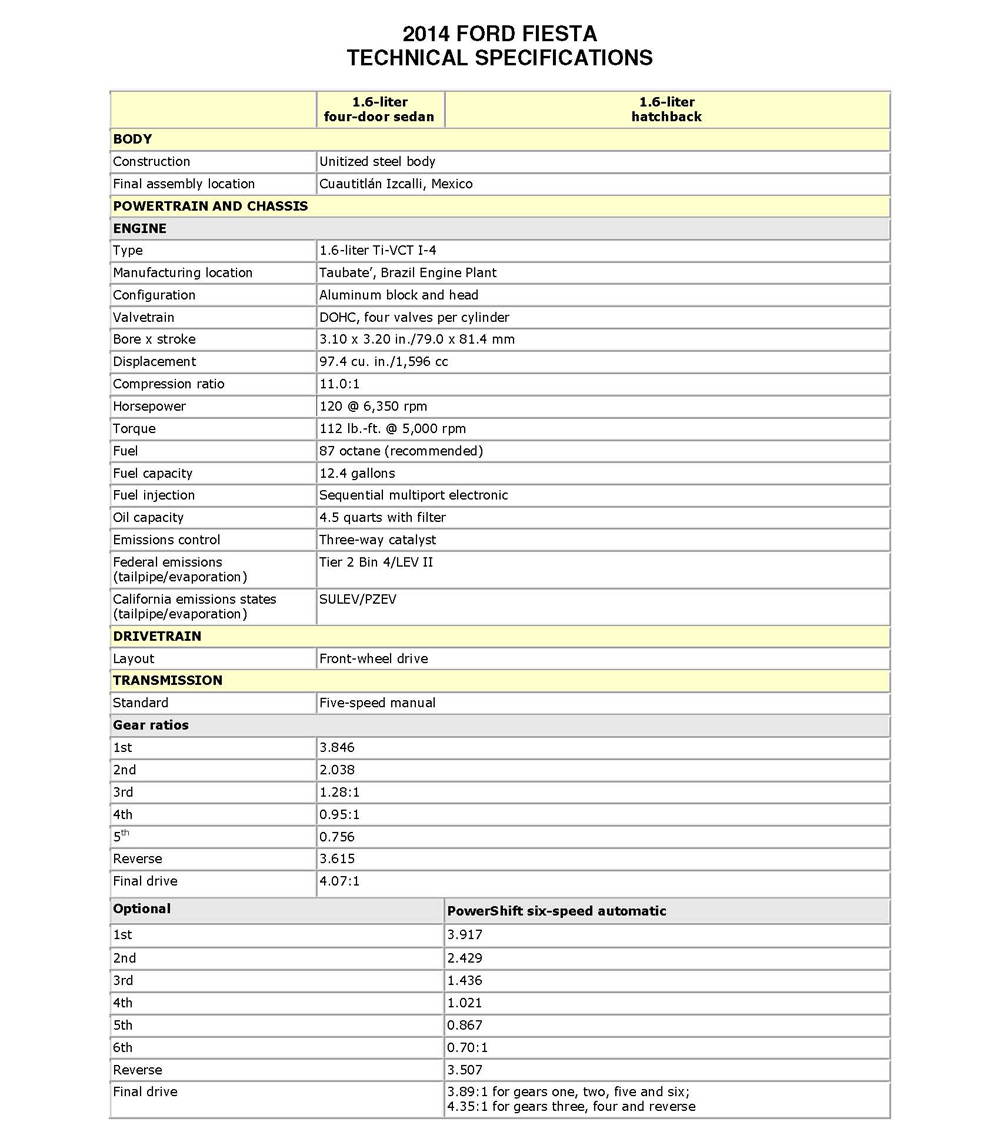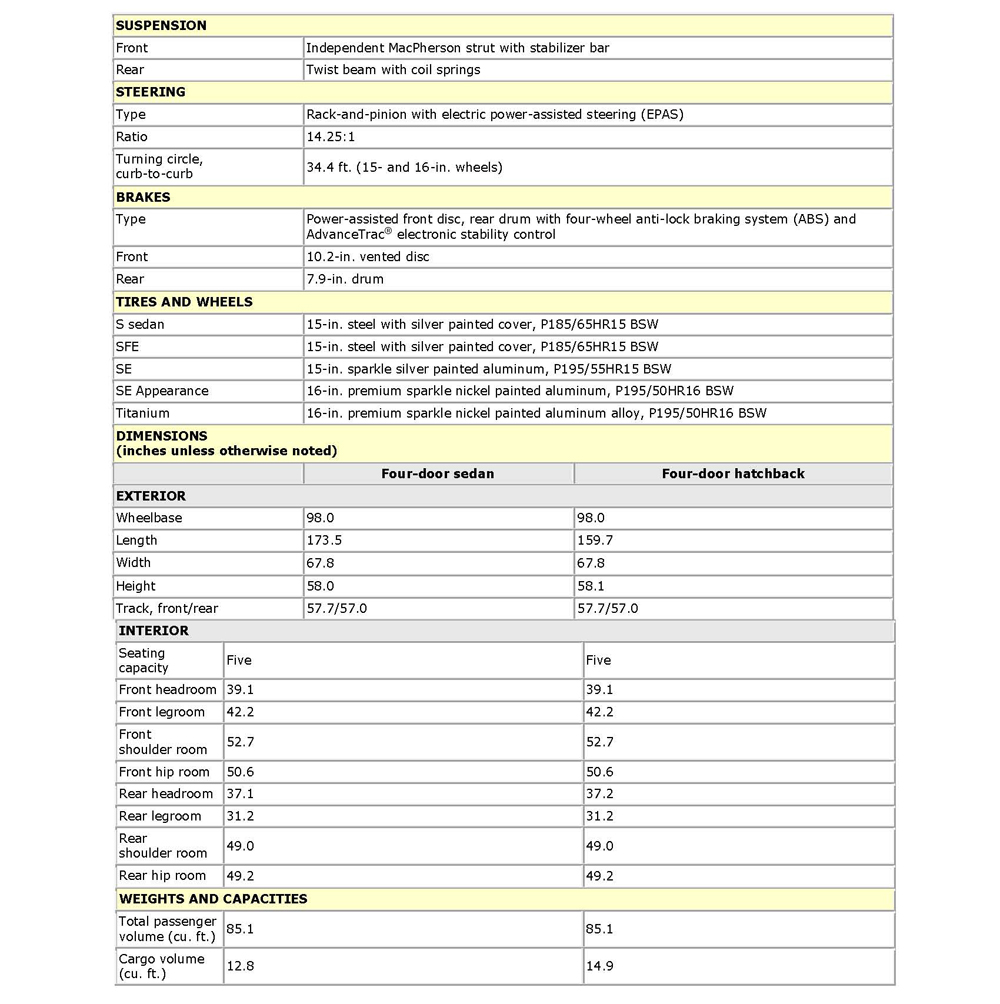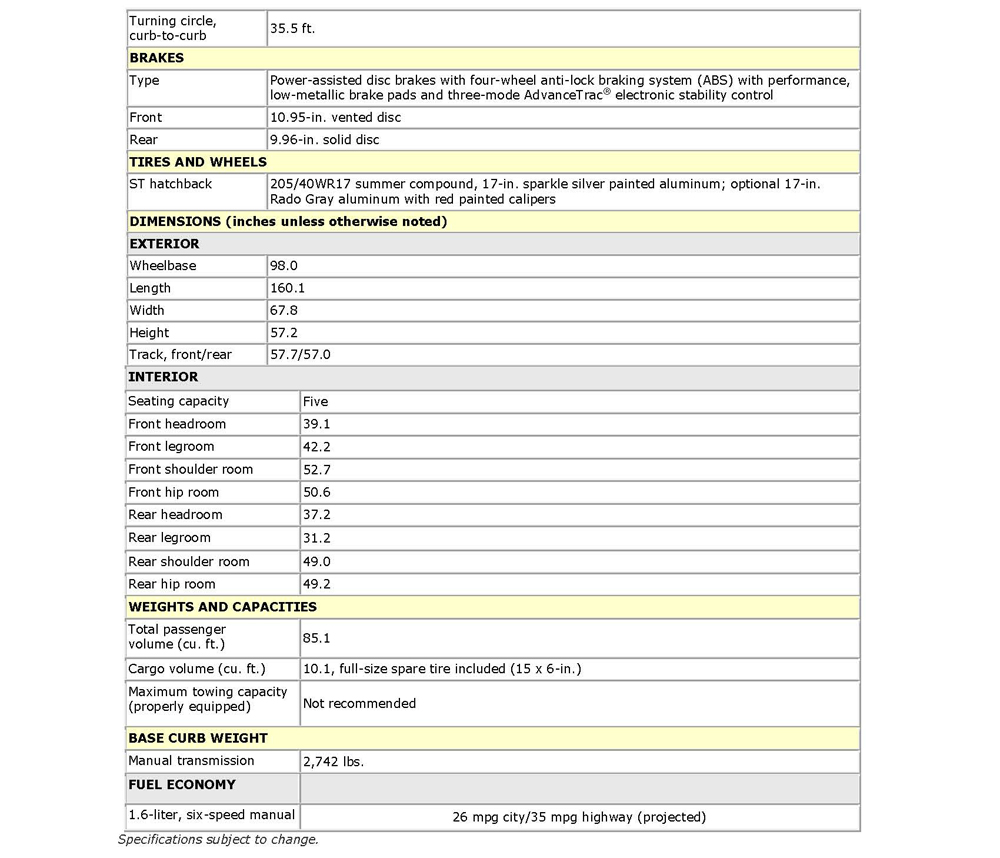
- New Ford Fiesta bursts onto the scene with an impressive lineup of powertrain options anchored by the award-winning 1.0-liter EcoBoost® engine that delivers a thrill-packed ride with 40 mpg-plus
- Fiesta is loaded with a dazzling array of features and technologies that prove small is smart
- Fiesta ST smokes the competition with the best performance in its class
Ford’s new Fiesta redefines the small car with a projected 40 mpg-plus fuel economy rating with the available 1.0-liter EcoBoost® engine, an exciting new look, and special features and technology that make it the most fun-to-drive car of its size.
Fuel efficiency and fun
The most dramatic and distinctive Fiesta to date will deliver impressive fuel efficiency, led by Ford’s patented new 1.0-liter EcoBoost engine. This landmark engine, already selected for both the Popular Mechanics 2012 Breakthrough Award and Engine Technology International’s International Engine of the Year award in Europe, is expected to deliver more than 40 mpg.
Fiesta will stand as a shining example of Ford’s commitment to provide customers with the most fuel-efficient cars, SUVs and trucks.
While the diminutive size of the 1.0-liter EcoBoost saves cash at the pump, it doesn’t hold anything back on the road. At 123 horsepower for each liter of engine displacement (the engine’s size), the 1.0-liter EcoBoost delivers more power for its size than a Lamborghini Aventador (at 108 horsepower per liter).
EcoBoost is fundamental to Ford’s strategy to provide technologically advanced, high-output, smaller-displacement powertrains that deliver uncompromised performance and fuel economy. EcoBoost engines deliver fuel economy gains of up to 20 percent and reduction of CO2 emissions of up to 15 percent, compared with larger, less-efficient engines. Ford’s leadership with EcoBoost has resulted in more than 125 patents on the technology.
Small is smart
In addition to its new EcoBoost engine, Fiesta boasts a best-in-class suite of technologies and features that give drivers the perfect blend of a connected world and an untethered driving experience.
A new MyFord Touch® system with 6.5-inch touch screen that features enhanced voice control is now available, providing drivers more options than ever for navigation, communication and entertainment functions. Fiesta still features SYNC® AppLink™ capabilities pioneered on the first Fiesta, which allows drivers to access and control Ford-approved smartphone apps with voice commands and vehicle controls while on the go, helping them keep their hands on the wheel and eyes on the road. Turn-by-turn navigation remains part of SYNC Services.
Ford’s MyKey® is a new feature on Fiesta, which enables parents in particular to encourage safer driving and limit their teenagers’ exposure to risk at the wheel. The system allows owners to configure maximum speed and audio volume limits. It also mutes audio until seat belts are fastened and ensures driver aids, safety systems and more vigorous alerts cannot be deactivated when used.
Built to excite the right-brain driver
Proving to be every bit as creative as its owner, the new Fiesta will offer custom exterior design graphics and sexy new color options. The redesigned exterior boasts a sporty new grille that reflects the new face of Ford.
Inside, things are just as expressive. The cell phone-inspired dashboard and available leather steering wheel and seats amplify the modern interior and entice drivers to get in the car and get on the move. A selection of ambient lighting options allows Fiesta drivers to set just the mood they want. Also available is a new Sony® HD audio/satellite radio with eight premium speakers for drivers to more fully appreciate their music.
Big on safety
Fiesta is a small car that is big on safety. It offers the following standard safety features:
- AdvanceTrac® with electronic stability control
- Dual-stage first-row airbags
- Driver knee airbag
- Side-impact airbags
- Side-curtain airbags
- Four-wheel Anti-Lock Braking System
- LATCH (Lower Anchors and Tethers for Children)
- Tire Pressure Monitoring System
- Child-safety rear locks
- Anti-theft engine immobilizer
- Improved side-impact safety capabilities
Fiesta ST pushes performance
Fiesta ST is Ford’s newest contribution to the world of hot hatches.
A new high-output variant of the award-winning 1.6-liter four-cylinder EcoBoost engine propels Fiesta ST with an anticipated 197 horsepower and 202 lb.-ft. of torque. In comparison, Mini Cooper S makes do with 181 horsepower and 177 lb.-ft., while Chevrolet Sonic RS produces 138 horsepower and 148 lb.-ft.
Unlike the competition, Fiesta ST doesn’t simply look like a performance car; it’s got the guts to back it up.
Fiesta ST may be born with racing DNA, but there’s no price for that performance at the pump. Available exclusively as a five-door hatchback in North America and with a six-speed manual transmission, Fiesta ST is projected to achieve 26 mpg city, 35 mpg highway and 29 mpg combined.

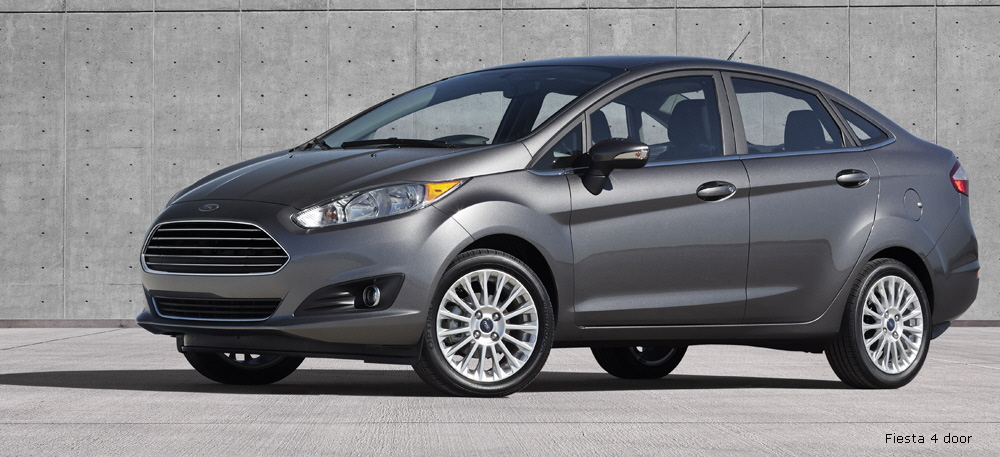



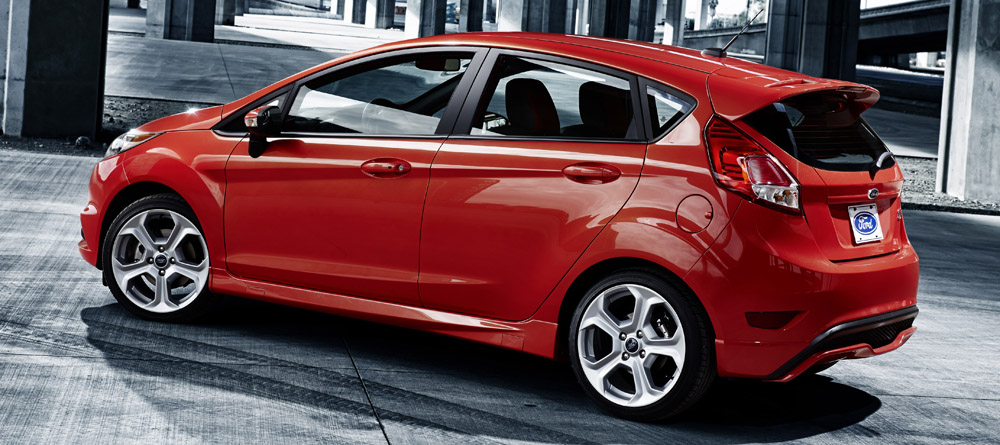

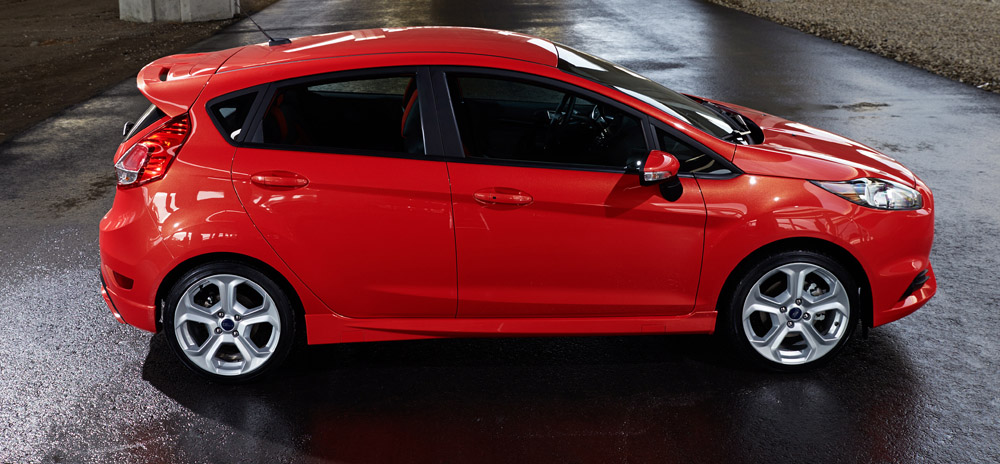
2014 Fiesta ST
- Fiesta ST – a well-known hot hatch born in Europe and now ready for North America – packs a punch with a 1.6-liter EcoBoost® engine producing nearly 200 horsepower
- New Fiesta ST is Ford’s latest vehicle to wear the Sport Technologies badge, a global performance brand that debuted in North America with the launch of the Focus ST
- Exclusively equipped with a six-speed manual transmission, Fiesta ST is expected to be a segment leader in both performance and fuel efficiency
Small cars continue to be a hot segment in North America, and with the new 2014 Fiesta ST, Ford is expected to have the hottest hatch around.
Fiesta ST, a performance model first launched in Europe back in 2005, is yet another proof point from Ford that small cars are anything but boring. In addition to a precision sport-tuned suspension and improved braking system, Fiesta ST packs a punch under the hood.
A new high-output variant of the award-winning 1.6-liter EcoBoost® four-cylinder engine propels Fiesta ST with an estimated 197 horsepower and 202 lb.-ft. of torque. In comparison, Mini Cooper S makes do with 181 horsepower and 177 lb.-ft., while Chevrolet Sonic RS produces just 138 horsepower and 148 lb.-ft.
Unlike the competition, Fiesta ST doesn’t simply look like a performance car; it’s got the guts to back it up.
Fiesta ST may be born with racing DNA, but buyers won’t have to pay for that performance at the pump. Available exclusively as a five-door hatchback in North America and with a six-speed manual transmission, Fiesta ST is projected to achieve up to 26 mpg city, 35 mpg highway and 29 mpg combined.
This compact performance machine sports a unique grille and chin spoiler with new rear diffuser and fascia extensions. Bright tipped dual-exhaust pipes and high-mount spoiler along with unique 17-inch wheels complete the visual package: Fiesta ST looks like it’s made for the racetrack. The car is first of its nameplate to receive the Molten Orange tri-coat metallic paint.
Fiesta ST steering is more direct and responsive than the base model. A unique suspension with modified front knuckle makes for a quicker overall steering ratio of 13.6:1.
The rear axle gets increased roll stiffness to improve stability through fast corners, while the Fiesta ST body sits 15 millimeters closer to the ground than the base model.
Increased mechanical grip provided by the suspension improvements is further enhanced with electronic Torque Vectoring Control to reduce understeer during hard cornering maneuvers. Three-mode electronic stability control – standard, sport or off – enables the ST driver to select the amount of electronic aid based on current conditions. Overall, Fiesta ST provides enthusiastic drivers with the ideal mix of performance handling and ride comfort.
Fiesta ST will also sound good on the open road. It features a modified version of the sound symposer implemented on other Ford products. The sound symposer provides an enhanced soundtrack for drivers out tackling the open road. It is unique for Fiesta in that for the first time the engine sound is directly fed into the passenger cabin to accentuate feedback quality and response.
Fiesta ST is the result of the combined efforts of Team RS in Europe and SVT in the United States.
2014 Ford Fiesta Earns Best-in-Class 41 MPG on the Highway
- 2014 Ford Fiesta achieves best-in-class highway fuel economy
- Ford Fiesta becomes only car in subcompact class to return more than 40 mpg on the highway
- Ford Fiesta Super Fuel Economy package combines aerodynamics and a patented PowerShift six-speed automatic transmission
The new 2014 Ford Fiesta has achieved 41 mpg in EPA testing. Fiesta is the only subcompact car to surpass 40 mpg.
The fuel economy claim is for Fiesta SE with the Super Fuel Economy package that includes Ford’s 1.6-liter engine and PowerShift automatic transmission. Along with the EPA-certified 41 mpg highway rating, Fiesta achieves 30 mpg in the city and 34 mpg combined.
The claim is significant because fuel economy is often cited as the No. 1 reason for purchase consideration in the subcompact class, according to Ford data. The new 2014 Fiesta will be arriving in dealers soon.
“The 2014 model is shaping up to be a game changer for Fiesta,” said Liz Elser, Ford Fiesta marketing manager. “With the addition of Fiesta ST and the award-winning 1.0-liter EcoBoost®, we have fantastic performance and fuel efficiency. But with today’s news, buyers will have a fuel-efficient Fiesta no matter which they choose.”
Two key technologies help Fiesta achieve fuel economy leadership – its advanced aerodynamics and dry, dual-clutch PowerShift automatic transmission.
In terms of aerodynamics, the SFE package adds rear spoiler, side air deflectors, underbody shields, lower grille blockers, low-rolling-resistance tires and cruise control. Together, these features decrease the amount of fuel needed to push the car through the air at speed.
The second enabler is the PowerShift transmission. Unlike regular, hydraulically operated automatic transmissions that use power-sapping torque converters, wet clutches and pumps, Ford’s new dual-clutch PowerShift automatic consists of two manual transmissions – in the same case – working in parallel. Each has its own independent clutch unit controlled by computers, and fast-acting electromechanical actuators that shift the gears.
In addition to the leadership claim for highway fuel economy, the new Fiesta boasts a best-in-class suite of technologies and features that give drivers a connected, yet untethered, driving experience.
A new MyFord Touch® system with 6.5-inch touch screen featuring enhanced voice control is now available, providing drivers more options than ever for navigation, communication and entertainment functions. Fiesta still features SYNC® AppLink™ capabilities pioneered on the first Fiesta, which allow drivers to access and control Ford-approved smartphone apps with voice commands and vehicle controls while on the go, helping them keep their hands on the wheel and eyes on the road. Turn-by-turn navigation remains part of SYNC Services.
Ford MyKey® is a new feature for Fiesta, which enables parents to encourage safer driving and limit their teenagers’ exposure to risk at the wheel. The system allows owners to configure maximum speed and audio volume limits. It also mutes audio until seat belts are fastened and ensures driver aids, safety systems and more vigorous alerts cannot be deactivated when used.
Ford Launches New Fuel-Efficient 1.5-Liter EcoBoost Engine; Boosts Company’s Global EcoBoost Capacity
- Ford announces new fuel-efficient 1.5-liter EcoBoost® engine, extends successful EcoBoost lineup to meet global demand for four-cylinder EcoBoost engines
- Ford now has capacity to build 1.6 million EcoBoost engines annually, triples number of plants that produce EcoBoost engines in Europe, Asia and North America from 2010 to 2013
- 1.5-liter EcoBoost offers trademark EcoBoost turbocharging, direct fuel injection and variable valve timing; delivers power of a larger engine with smaller unit economy
- Fifth Ford EcoBoost engine delivers new innovations, and significant consumer benefits in global markets offering tax reductions for vehicles equipped with engines of 1.5-liter capacity or less
Ford Motor Company announces a new 1.5-liter EcoBoost® engine will join its lineup of fuel-efficient, innovative powertrains. The 1.5-liter engine is a key strategic entry for Ford, as the company works to meet strong global demand for its four-cylinder EcoBoost engines.
With the launch of this newest fuel-efficient engine, Ford now has capacity to build 1.6 million EcoBoost engines annually. By the end of 2013, six plants across Europe, Asia and North America will be producing EcoBoost engines, triple the number that were doing so in 2010.
Production of the four-cylinder 1.5-liter EcoBoost – the fifth member of the EcoBoost family – will commence initially at Ford’s world-class facility in Craiova, Romania, later this month. Other manufacturing locations will be announced in the future. The new engine will be first introduced in China in the all-new Ford Mondeo, making its public debut later this month at Auto Shanghai 2013, with applications following in the Fusion sedan in North America this year, and later the new Mondeo in Europe.
As a key contributor to Ford’s aggressive fuel economy and emissions strategy, EcoBoost technologies enable improvements to both fuel efficiency of 20 percent and emissions of up to 15 percent. The 1.5-liter engine benefits from signature EcoBoost turbocharging, direct fuel injection and variable valve timing, and has been designed to be even more fuel efficient and offer high levels of refinement, quietness and performance.
Additionally, the newest EcoBoost engine will be a strategic entry for Ford in global markets that offer tax relief to consumers who purchase vehicles powered by engines of 1.5-liter capacity or less.
The new aluminum-block, twin-cam 1.5-liter EcoBoost engine will include some of the innovative features introduced on the award-winning 1.0-liter EcoBoost such as an integrated exhaust manifold. The new engine is expected to provide similar horsepower and torque performance to Ford’s current 1.6-liter EcoBoost, while delivering improved fuel economy and lower CO2 emissions.
The 1.5-liter EcoBoost is the first engine from Ford to incorporate a computer-controlled clutch on the belt-drive water pump, which further improves efficiencies by reducing warm-up time. A water-cooled charge air cooler is added to offer a more efficient feed of air into the engine.
“Ford EcoBoost technology has changed the way people look at gas engines and has enjoyed huge success with customers,” said Joe Bakaj, vice president, powertrain engineering for Ford. “The new 1.5-liter unit further extends our EcoBoost promise of economical driving in terms of both fuel efficiency and – in some markets – tax savings.”
Ford has sold more than 600,000 EcoBoost-equipped vehicles globally since the range was launched with the 3.5-liter V6 EcoBoost in 2009. Ford added the 2.0-liter EcoBoost in 2010, the 1.6-liter EcoBoost followed in 2011, and last year the 1.0-liter EcoBoost was launched, winning the 2012 “International Engine of the Year” award.
By the end of this year, nearly 80 percent of the company’s global nameplates will be available with fuel-saving EcoBoost technology.
FORD FIESTA – DESIGN AND FEATURES
The all-new Fiesta brings a fresh, new face to small car form and function.
Fiesta’s simple, harmonious design clearly signals its package efficiency, its strong driving quality credentials and a special zest for life. Fiesta’s shape distils the design cues that are central to every new European Ford car to their very essence. The latest Fiesta reflects Ford’s New Edge design philosophy while creating a distinctive small-car character with solidity and roominess.
Key Design Elements
Fiesta’s vibrant design signals the space inside by putting emphasis on the cabin area. The bonnet is short; the glass area is generous giving the interior a light and roomy feeling.
The new exterior design is characterised by well-balanced proportions that help it retain subtle links with its forebears. The front of the vehicle is dominated by large, expressive headlamps that signal technical competence by showing every working detail.
The design visually communicates Fiesta’s dynamic capabilities. With an extended wheelbase and wider track than the previous model, the wheels stand more firmly on the road, poised for action.
The Fiesta’s daylight opening (DLO) area between the belt line and the roof appears to be all glass from the A-pillars right around the car, because the B- and C-pillars are blacked out or covered by semi-flush side glass. A body-colour D-pillar has been wrapped around the side of the vehicle, which in conjunction with the high wrapped tail lights, makes the car visually compact and dynamic.
A word seldom heard in the small-car market, spaciousness, is the first impression created by the interior. Key design elements complement the generous interior package of the vehicle, appealing to the head with strong functionality and outward visibility while appealing to the heart with inviting comfort for family and friends.
The new instrument cluster design is inset directly in front of the driver for optimised centerline visibility. The dials have clear white graphics on dark faces with LCD displays for trip and total distance and the clock.
The door panels also are completely new, and provide improved functionality including integrated armrests with full-grip door pulls and large audio speakers with integrated covers inserted into the front upper corner of each trim panel to avoid sound masking.
The new Fiesta also is full of features, including new and innovative touches made possible by completely new integrated electrical architecture, such as a dash mounted boot release and hazard lights switch, remote radio controls mounted on steering column, headlamp leveling and many more.
Front Design Elements
The front-end personality of the new Fiesta design shows close links with the rest of the Ford family with bold graphics, clean simple surfacing and pronounced wheel arches.
Fiesta’s friendly new face is characterised by the wide, truncated elliptical grille that intersects with the large vertically stacked headlamps and indicators. The lower grille features an inverted trapezoid shape that further emphasises Fiesta’s wide track and ‘planted’ stance and provides a mounting point for integral fog lamps at the very front corners on the five-door Ghia and all three-door models.
The pronounced wheel arches communicate the dynamic capabilities of the vehicle along with a distinctive bodyside feature line that dives downward dynamically from the rear of the vehicle all the way to the front wheel arch.
The sculptured headlights that wrap around the corners and over the hood top, project a sense of fun. The large clusters incorporate a two-level design housing all front lighting functions, including headlamp beams, direction indicator and small running lamp.
The chopped, elliptical grille has become a Ford brand design trademark and this arc shape clearly communicates that Fiesta is an integral part of the Ford family. The lower grille ‘legs’ lean outward to further emphasise the vehicle’s dynamic capabilities.
The influence of the package and ergonomics team is seen with the low cowl and distinctive shape of the bonnet design, which has been specifically profiled to provide a driving aid for shorter drivers for whom a height adjustable seat is also provided as standard equipment. At least 50 per cent of its width contour can be seen by 95 per cent of the stature range of women, making the new Fiesta easy to manoeuvre for all customers.
The new Fiesta has been designed with a flush-mounted windscreen for a higher quality visual appearance and optimised forward vision. In fact, all of the new Fiesta’s fixed glass panels are direct-mounted.
The large Daylight Opening (DLO) area of the new Ford Fiesta signals its impressive interior spaciousness and outstanding outward visibility. The Fiesta’s large interior package doesn’t relegate the rear-seat passengers to second-class status.
The short distance from the top of the front headlamp to the DLO balances the proportions to emphasise the importance of the occupant compartment to the overall design, communicating package strength and agility. Viewed from the side, Fiesta’s new teardrop shape and wedged body accent lines communicate its infectious spirit of agility and driving fun.
The new Fiesta is clearly a member of the Ford oval family but with a character statement of its own. Its elements combine to affect a simpler, more harmonious vision that signals the emphasis on quality achieved through Europe’s most modern automotive assembly operations. Fiesta’s spirit is inviting. It wants to share the enjoyment.
The new Fiesta design communicates its quality with fewer visible shut lines seen here between the door top and the roofline. The remaining gaps are 30-per cent narrower and even more uniform in the new vehicle.
The characteristic Focus-inspired rear pillar has been achieved by the body colour D-pillar being pulled around the side of the vehicle. In conjunction with the high wrapped tail lamps, this makes the car visually compact and communicates Fiesta’s dynamic capabilities.
High tail lamps continue to be a Ford design cue with the added safety of high-mounted tail lamp clusters. With the exception of Fiesta’s center high-mounted stop lamp, all lamp functions are now contained in these units. There are no low-mounted lamps in the bumper, only subsidiary reflectors. This design costs less to repair in the event of damage in minor, car-park type collisions.
Fiesta’s rear view reflects the simplicity and harmony of the vehicle’s overall design, signaling the precision and quality of the technology within.
Three-door Fiesta Style
Fiesta’s new three-door model evokes a unique image that distinguishes it from its five-door counterpart. The three-door model looks compact, sportier and even more dynamic. Behind the different personality created for the three-door by Ford designers, it shares a common genetic profile with the Fiesta five-door, including many common dimensions. Both have the same ‘face’ and are identical below the body crease line. But it is the Fiesta three-door’s unique profile with its sloping roofline and more angled tailgate glass that gives it a special spark of sporty personality.
Creating a visual separation between the two Fiesta models was important. Ford’s goal with the Fiesta three-door was to achieve a sportier, more agile style reflecting the aspirations of three-door buyers and signaling the dynamic driving quality of the new Fiesta.
The design team first set about lowering the roof profile by rocking the roofline from the top of the A-pillar and pulling it down towards a lowered rear header. The whole daylight opening (DLO) was made sportier by increasing the wedge of the beltline and by dropping the upper line much lower than on the Fiesta five-door model. The rear edge of the DLO was also pulled forward and angled more dramatically to emphasise the car’s compact and dynamic character.
As a result, the tail lamp is further forward, though it wraps around the C-pillar in a similar fashion to the five-door. The tail lamp is also shorter as a result of the visually integrated spoiler look at the top of the tailgate. This helps make the car look more squat from the rear view. Despite these differences, the overall physical length of the three-door and five-door variants is identical and comfortably accommodates three passengers in the rear.
Space and Comfort
The Fiesta three-door convincingly dispels conventional wisdom that three-door cars are smaller and less comfortable than their five-door counterparts. The Fiesta three-door boasts the same feeling of spaciousness and comfort, and provides its occupants with excellent rear-seat accessibility.
Both variants are identical in the front part of the cabin, providing generous front seat roominess in every dimension. Rear passengers benefit from class-leading knee clearance and, for Fiesta three-door passengers, the absence of a door means a gain in rear-seat width, resulting in class-leading available shoulder room, totaling 1355 mm.
The coupé-like sloping roof has been designed to intrude as little as possible on rear headroom, with a loss of a mere 8 mm compared to the five-door. All passengers gain extra stowage space thanks to larger front door bins and the introduction of additional stowage bins to the side of the rear seat.
Getting in and out of the new Fiesta is easy, thanks to the elongated doors – 248 mm longer at 1,359 mm – which allow a wider opening and, at the same time, improved ‘foot’ space.
Fiesta Interior: Packaged for Enjoyment
Fiesta’s interior design is airy and spacious, enhanced by large glass areas. Attention to detail led to harmonious colour choices and a feeling of quality throughout the interior. Special attention has been paid to colour harmony between all components and materials. The new front and rear seats combine dual trim materials and patterns for a harmonious feel. The design of the seats are geometric and powerful, developed depending on the colour environment and series.
Front and rear seats have deadpan foam cushions and steel-framed, sprung-wire backrests, with cut-and-sew covers. Front seats are adjustable fore and aft, while the driver’s seat has an additional height adjustment.
Fiesta front doors incorporate a recessed map pocket and a built-in drinks holder, designed specifically for soft-drink cans.
The new Fiesta features a new rear seat design that enhances the comfort provided by the most generous knee room in the segment. The seat incorporates three new ‘shingle style’ head rests that can be lowered to be flush with the top of the seats, a measure that aids in the driver’s rearward visibility when there are no rear-seat passengers.
This head rest type has another plus: its clever design means that it doesn’t have to be removed and stowed somewhere when the seat is folded down for the loading of large cargo items in the boot. It’s another example of how the new Fiesta eliminates many of the frustrations of the typical small car.
The rear seat features a 60-40 seat-back design. The seat bottom folds up to allow the seat back to fold flat. These flexibility features enhance Fiesta’s usable cargo volume.
The Fiesta three-door’s load volume varies slightly from the five-door due to its revised tailgate and sloping roof profile. VDA boot volume is 261 cubic litres, as compared with 283 litres for the five-door.
Driving quality touch: leather-wrapped, height-adjustable steering wheel A leather-wrapped steering wheel is a standard feature across the range, except in the 1.4-litre 5-door model. The special feel of leather further communicates the priority driving quality plays in this all-new small car.
The new Fiesta also features power-assisted steering as standard equipment across the range. Fiesta’s manoeuvrability also is exemplified by its under-10-metres turning circle. There are only 2.8 turns of the steering wheel from lock to lock. The steering wheel is also height adjustable by 50 mm.
The Fiesta instrument panel and driver controls are not overtly configured in cockpit fashion, reflecting the spirit of sharing with the other vehicle occupants, although everything is still within easy reach of the driver.
The new Fiesta is full of features, including new and innovative touches made possible by its new integrated electrical architecture. The new approach to Fiesta’s electrical system has eliminated 40 per cent of the wiring used in the previous model.
The new instrument cluster incorporates an electronic speedometer and tachometer, with backlit dials and moving analogue needles that are illuminated throughout their length by fibre optics. The ‘total’ and ‘trip distance’ odometers are incorporated at the base of the speedometer dial as a tamper-resistant LCD panel.
The instrument cluster communicates with the engine management module. The engine management module sends data on engine speed and temperature directly to the tachometer and temperature gauge as well as vehicle speed data to the electronically driven speedometer.
A large rotary switch on the dash falls easily to hand for all main lighting functions. Similarly, the hazard-warning switch is mounted centrally on the dash panel for ease of use by both front-seat occupants.
The new Fiesta features a new and unique “stacked component style” audio system that allows a high degree of flexibility.
No drips: The new Fiesta brings smart wiping technology. You’ve just washed the windscreen and it’s nice and clear, and then, inevitably, a drip slowly rolls down in front of your face. The new Fiesta knows it’s coming and automatically comes back for another sweep of the wipers two seconds after the wash cycle is complete.
When the front windscreen wipers are on and the driver selects reverse gear, the rear glass wiper automatically activates to provide a clear rearward vision for the driver.
The electronically controlled remote boot release feature only operates if the vehicle is standing still or traveling at less than 7 km/h as a safety measure, and is standard across the range. The release button has been located high on the outboard of the instrument panel to make it easy to reach by the driver and also easy to operate from outside the vehicle by reaching through the driver’s door.
The interior courtesy lights feature theatre-style dimming when the doors are shut to offer a well-lit environment as you switch the ignition on.
To prevent the battery from going flat if the vehicle is left for a prolonged period, the courtesy lamps are automatically shut off after 10 minutes if left on. The map lights, door-ajar tone and tailgate lamps also switch off after a further 20 minutes. To prevent damage and help assure longer-term durability, the ‘smart start’ ignition system deactivates the starter motor if the driver inadvertently holds the key in the start position too long.
